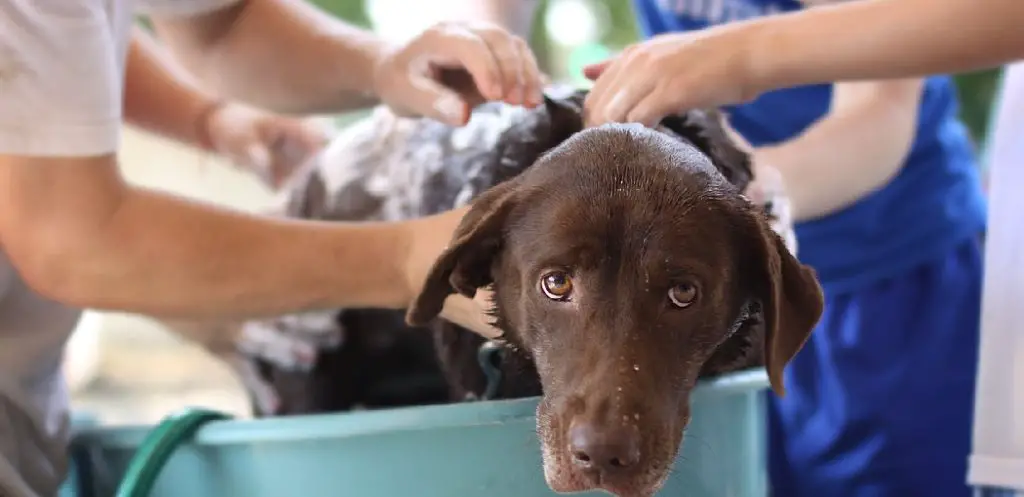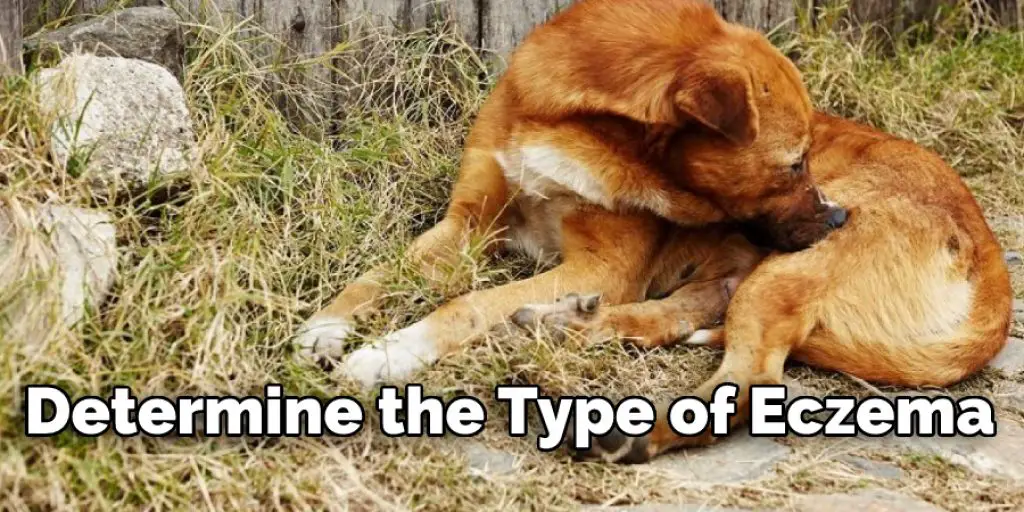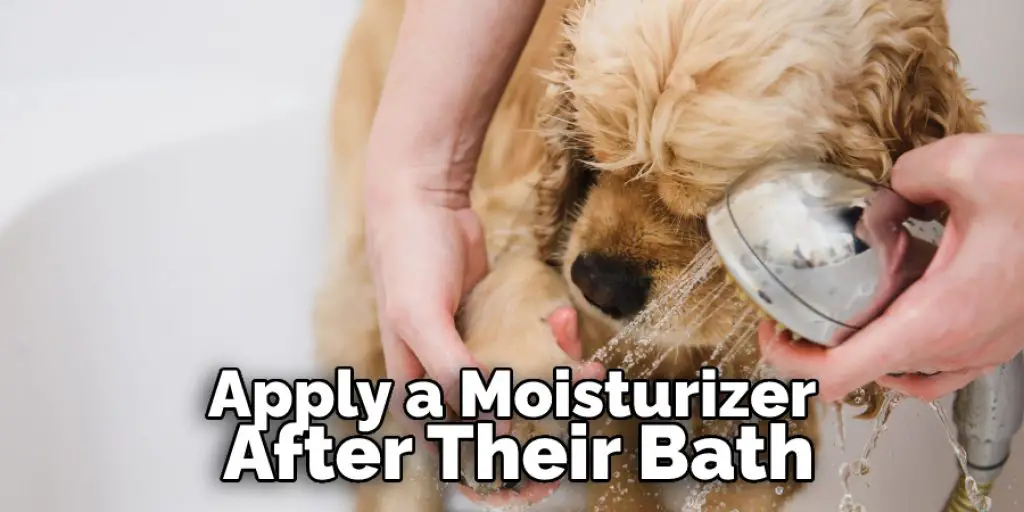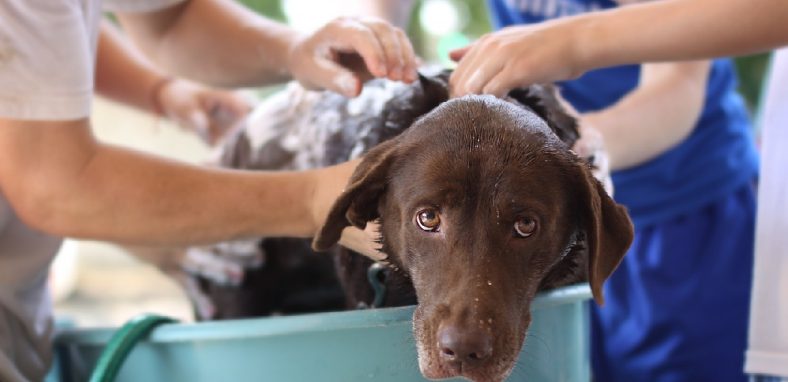Eczema is a frustrating skin condition that can make life miserable for you and your dog. While there is no cure, you can take steps to help ease the symptoms and prevent flare-ups. One of the most important things you can do is keep your dog’s skin clean and free of irritants. In today’s article, I wil show you how to wash a dog with eczema. Keep reading.

Dogs with eczema typically have very dry, itchy skin. The itchiness can be so severe that your dog may start to scratch and chew at his skin, leading to open sores and secondary infections. If you notice your dog scratching more than usual, check his skin for signs of redness, flakiness, or hair loss. These are all signs of eczema. The best way to help a dog with eczema is to keep his skin clean and moisturized. This will help reduce irritation and inflammation.
Contents
What is Eczema?
Eczema is a skin condition that can affect any dog but is most commonly seen in those with short hair or dogs with allergies. Eczema appears as a red, inflamed area of the skin and can be itchy and uncomfortable for your pet.
If your dog has eczema, it’s essential to keep the affected areas clean and free of irritants. You can do this by washing your dog regularly with a gentle shampoo specifically designed for pets with eczema. Be sure to rinse your dog thoroughly after washing to remove all traces of shampoo.
You can also help soothe your dog’s skin by applying a topical ointment or cream specifically designed for eczema. Talk to your veterinarian about what product is best for your dog.
What You’ll Need:
- Dog shampoo
- Warm water
- Towel
- Bucket
A Step by Step Guide on How to Wash a Dog With Eczema

Step 1: Before You Start
Determine what type of eczema your dog has. Two kinds of eczema commonly affect dogs: allergic contact eczema and atopic dermatitis. Allergic contact eczema is caused by an allergic reaction to something that has come into contact with your dog’s skin. Atopic dermatitis is a chronic condition caused by an overactive immune system response to something that is inhaled, ingested, or comes into contact with your dog’s skin.
Step 2: Choose a Shampoo
Not all shampoos are created equal, so choosing the right one for your dog’s eczema is essential. There are many different types of shampoos available on the market, but it is best to stick with those made specifically for dogs. In addition, some shampoos contain harsh chemicals that can irritate your dog’s skin, so it is essential to avoid these. Instead, look for a shampoo that is gentle and contains natural ingredients.
When choosing a shampoo, be sure to read the label carefully to ensure that it is appropriate for your dog’s eczema. If you are not sure which shampoo is right for your dog, ask your veterinarian for advice.
Step 3: Prepare for the Bath
Eczema can make your dog itchy and uncomfortable, so it’s essential to get them clean and help relieve their symptoms. But before you start the bath, you should do a few things to prepare.

First, gather everything you’ll need, including mild dog shampoo, a cup or pitcher for pouring water, and a towel. It’s also helpful to have a second person around to help hold your dog still during the bath.
Next, fill your tub or sink with lukewarm water. The water should be comfortable to touch since dogs have sensitive skin. Avoid using hot water as it can further dry out your dog’s skin and worsen their eczema.
Finally, test the water temperature on your dog’s skin before getting them wet. You can do this by wetting your hand and touching it to their skin. If it feels too hot or cold, adjust the water accordingly.
Step 4: Wet Your Dog’s Coat with Lukewarm Water
Lukewarm water is best for wetting your dog’s coat. It will help loosen any built-up dirt or oils and make it easier to rinse the shampoo later on. First, wet your dog thoroughly, getting the soap into all of their furs. You may want to use a spray bottle for this step rather than dunking them in a bathtub. If you’re using a hose outside, avoid getting the water directly in your dog’s face.
Step 5: Lather Up Your Dog’s Coat With Shampoo
Once your dog’s coat is wet, start lathering up the shampoo. Be sure to avoid getting any in their eyes or ears. You can use your hands or a washcloth to work the shampoo into their coat. If your dog has long hair, you may need a special brush to help get the shampoo evenly distributed.
Step 6: Rinse Your Dog’s Coat Thoroughly
After you’ve lathered up your dog’s coat, it’s time to rinse off all the soap. Use lukewarm water and continue rinsing until all of the suds are gone. Avoid using hot water as it can dry out your dog’s skin. Once you’ve rinsed away all of the shampoos, dry your dog off entirely with a towel.

Step 7: Apply a Moisturizer (Optional)
If your dog’s eczema is particularly dry or irritated, you may want to apply a moisturizer after their bath. Be sure to choose a specifically designed product for dogs, as some human products can be too harsh. Then, use the moisturizer liberally to your dog’s coat and massage it until it is fully absorbed. You can do this once a day or as often as needed to help relieve your dog’s eczema.
Step 8: Follow Up With Your Vet (Optional)
If your dog’s eczema does not improve after following these steps, or if it seems to be getting worse, make an appointment with your veterinarian. They will be able to give you more specific advice on how to treat your dog’s eczema and rule out any other possible causes of their itchiness. In addition, these steps will help in how to wash a dog with eczema.
Tips and Warnings:
Tips:
-If your dog’s eczema is severe, you may need to give them a medicated bath. Check with your veterinarian to see if this is necessary.
-Use a hypoallergenic shampoo and avoid using conditioner.
-Be sure to rinse your dog thoroughly.
-Pat your dog dry (do not rub) and apply a pet-safe moisturizer to their skin.
-Talk to your veterinarian about any other steps you can take to help manage your dog’s eczema.
Warnings:
-Do not use human shampoo or soap on your dog, as this can dry out their skin and worsen eczema.
-Do not bathe your dog more than once a week, as this can also dry out their skin.
How Can I Treat My Dogs Eczema Naturally?

There are a few things you can do to help your dog if they are suffering from eczema. One of the best things you can do is to try and soothe the itchiness with a natural oatmeal bath. You can make an oatmeal bath by grinding up some oatmeal in a blender or food processor until it forms a powder. Then, add the powder to your dog’s bathwater and let them soak for about 15 minutes. This will help to relieve the itchiness and inflammation associated with eczema.
Another thing you can do is to apply a topical cream or ointment designed for humans with eczema. Choose one that does not contain any steroids, as these can further irritate the skin. You may need to experiment with a few different products before finding one that works well for your dog, but this is often an effective way to treat eczema.
Finally, you’ll need to be extra careful about your dog’s diet if they have eczema. Many dogs with eczema are allergic to certain ingredients in their food, so it’s essential to find hypoallergenic food that does not contain any of the substances your dog is allergic to. This can be a bit of trial and error, but it’s worth it to help your furry friend feel better.
If you follow these tips, you should see a noticeable improvement in your dog’s eczema symptoms.
How Often Should You Wash a Dog With Eczema??
The frequency of baths may need to be increased during eczema flare-ups and decreased during periods of remission. How often you wash your dog will also depend on the severity of eczema and your dog’s individual needs. In general, it’s best to consult with your veterinarian to find a bathing schedule that works best for your dog.
There are various products available that can be used to safely and effectively cleanse dogs with eczema. However, it’s important to avoid using harsh or drying products, as this can further irritate the skin. When choosing a product, look for something designed specifically for use on sensitive skin. You may also want to consider using a pet-specific shampoo and conditioner, as these products are often more gentle than those designed for use on humans.
Conclusion:
Suppose your dog is suffering from eczema, several ways to help them. One of the most important things you can do is keep their skin clean and free of bacteria. You can do this by washing them with a gentle shampoo that will not irritate their skin. There are also special shampoos available for dogs with eczema. By following these tips on how to wash a dog with eczema, you can help your dog get relief from their eczema symptoms.


